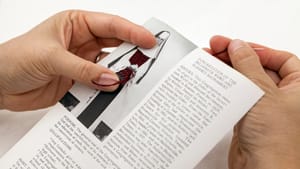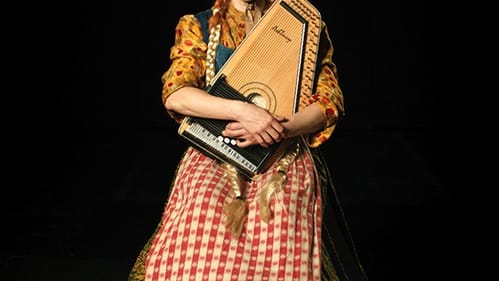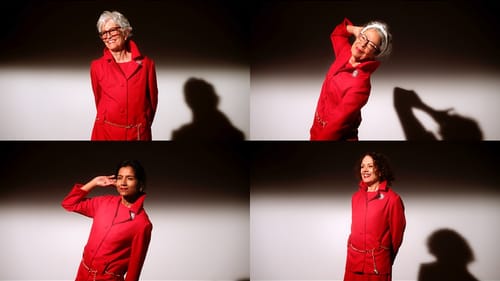Stay in the Loop
BSR publishes on a weekly schedule, with an email newsletter every Wednesday and Thursday morning. There’s no paywall, and subscribing is always free.
Women in jeopardy, across the century
The Fabric Workshop and Museum presents Suzanne Bocanegra’s ‘Poorly Watched Girls’

Suzanne Bocanegra consumes culture differently from most of us. Poorly Watched Girls, on view at Fabric Workshop and Museum (FWM), is her take on an opera, a book, a ballet, a snippet of forgotten film, and a family memory. Four multimedia installations completed during the artist’s residency at FWM find a loose link in the theme of women in jeopardy in popular entertainment.
While a typical theatergoer emerges humming a tune that evaporates on the evening air, Bocanegra leaves with ideas sparking. Instead of winking out, they burst into art that flies far from the material that inspired them.
Setting memory to music
Lemonade, Roses, Satchel (2017) is the most personal, and the most memorable, of the works here. A Texas farm where Bocanegra spent summers with a grandmother mired in dementia sowed that seed. “Would you like some lemonade?” her grandmother asked incessantly, “My roses are so beautiful. Why won’t [my husband] give me money for my satchel?”
The artist, who collaborates widely in her work, asked composer/singer Shara Nova to create a song from the disjointed reverie. Then Bocanegra costumed Nova as a rural dairymaid and filmed her performance. Crowned with a wheatsheaf, the singer strums an autoharp, wearing a checked apron with roses pinned at her waist. She performs the plaintive, haunting melody without pause and without expression, projected on a wall of a darkened gallery.

Talking with nuns
Francis Poulenc’s 1950s opera Dialogue of the Carmelites led Bocanegra to undertake a conversation of sorts with women religious. Disassembling a 1955 reference book for prospective postulants, A Guide to the Catholic Sisterhood in the United States, she anointed the pages with needlework, embellishing photographs of more than 150 professed nuns in the habits of their religious orders.
The book unfolds around the perimeter of the gallery, pages propped along a narrow ledge halfway up the wall. A chant — another collaboration — plays softly overhead. The mid-20th century was the high-water mark for girls and women entering convents before the sweeping changes of Vatican II and the women’s movement, and it’s fascinating to read the descriptions of the orders, their purpose, applicant qualifications, and manner of worship, while considering how many women committed their lives in this way.
Some of the communities look extremely limited to 21st-century eyes, but 70 years ago, religious orders sometimes offered women — in addition to the ability to pursue vocations — educational and work opportunities, as well as security and freedom, that they may not have had in secular society.
Pain in watching
Bocanegra’s exhibition takes its name from the French ballet La Fille Mal Gardée, a tale of young love and parental disapproval first performed in 1789. In La Fille, Bocanegra takes the role of costumer and scenery designer, transporting viewers backstage with costumed mannequins and stage sets.
“Through the use of costumes and scenography,” she says in gallery signage, “I’ve staged my own version of a romantic agricultural idyll and the watching of this girl.” Specifically, Bocanegra found inspiration in Frederick Ashton’s 1960 staging of the dance, in which ballerinas danced en pointe in wooden clogs. Clogs of varied shapes and sizes stand by each costume, leaving viewers to imagine the dancers’ pain.

Judy Garland lives
Valley is the recreated version of Judy Garland’s 1967 wardrobe test for Valley of the Dolls, a film the actress never completed. Collaborating with eight woman artists she admires, Bocanegra recreated the ensembles and instructed the women to mirror Garland’s actions in the archival footage. Viewers enter FWM’s darkened eighth floor to see silent images of the eight women simultaneously reenacting Garland as she models the outfits, plays to the camera, and mouths comments to an unseen director. As the group imitates the actress, the aborted project becomes a metaphor for Garland’s tragic life.
No artist is an island
Reinterpretation is a technique Bocanegra often uses on herself, delivering a talk through onstage actors. An actor repeats her words for the audience as Bocanegra speaks them into a mic heard only in the actor’s earbud. A February 8 lecture, featuring actress Lili Taylor, is among the events planned in connection with Poorly Watched Girls. The artist spoke of the method in a 2017 interview with John Haskell:
The Venus de’ Medici or the Dying Gaul are obviously marble statues, yet we admire their realness. Actually, we marvel at their fake realness. But more importantly, we admire their heightened beauty and emotional expression when illusion is manipulated to great effect.
That is never accomplished by exact imitation. It can only be accomplished by interpreting reality. A really good actor can do this. With the force of their personality and their physical body, they can manipulate an illusion of someone else to great effect.
Poorly Watched Girls is a reminder that no work of art is created in isolation, and the impact of a book or opera or piece of film can extend far beyond its own medium, genre, and period to inspire something tangentially related yet completely different.
What, When, Where
Suzanne Bocanegra: Poorly Watched Girls. Through February 17, 2019, at the Fabric Workshop and Museum, 1214 Arch Street, Philadelphia. (215) 561-8888 or fabricworkshopandmuseum.org.
Sign up for our newsletter
All of the week's new articles, all in one place. Sign up for the free weekly BSR newsletters, and don't miss a conversation.
